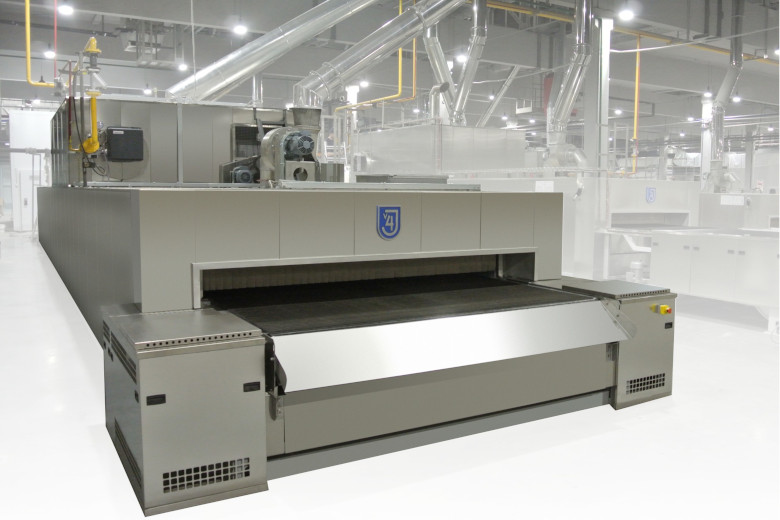
Under the current circumstances, it has never been more important to look into ways to increase efficiency in bakeries, starting with their centerpiece: the tunnel oven. Mindful technology innovation is here to provide benefits in efficiency and sustainability. Baking a vast range of high-quality products is only the start of what cutting-edge tunnel ovens can do.
J4: the optimum baking curve
Czech Republic specialist J4 looks at the optimum baking curve for a wide variety of products when designing its tunnel ovens. To ensure it is consistently being reached, each step (and its dedicated zone) of the baking process is controlled. “For an example of a possible setup, an oven with a baking area of 4 x 22.5 m has five baking zones and one heating tower. For each zone, the temperature is automatically regulated, according to the recipe, with a pre-set ratio of bottom and upper heat,” J4 specialists explain. In addition, ‘STIR’ is incorporated in J4 ovens – a patented technology that changes radiant heat to infrared heat, helping the product to develop core temperature faster, and the final volume of the product, while contributing to the process efficiency by shortening baking times. STIR was developed by J4 in cooperation with German company IBT; thanks to a special coating applied to a part of the baking chamber, the heat resonance is changed so that it penetrates the product’s surface and reaches its core more easily. Optional oven accessories that are commonly used are the ‘Duotherm’ (a turbulence zone helping at the beginning of the baking process to heat pan straps and at the end, for fine-tuning the crust and color) and the exhaust fan, used for proper moisture management inside the oven. The system not only controls the current status of the oven, but also adjusts the process according to information received from the line, such as gaps between products, to always maintain the closest possible temperature to the one set in the recipe.
Setting the best baking curve is the first step in production. The baker’s skill and experience play the main role in perfecting it, based on information about the product and the materials used, and by testing the oven’s parameters.
The company shows how it can contribute with custom setups: “To get a perfect product, we offer solutions that include steam and moisture management, changes in the baking system itself, or combining heating methods (radiant/convection/infrared – direct/indirect)m and oven control.”
The amount of moisture is related to the volume of air exhausted from the baking chamber. In turn, the volume of air going out is related to the speed of the fan, J4 explains.
Looking at every product
These settings vary for each type of product. For example, bread products need a high temperature at the point of contact with the oven belt and in the first zone, J4 specialists illustrate. Buns have a smoother temperature curve mid-way through baking. For their smoothness and shine, steam is released along the baking chamber. The cyclothermic oven with a shifted tower is mainly used for rye-wheat bread, where the high temperature in the first zone gives the best result. Rye products are steamed in the beginning; it is then best to bake them with very low moisture. “All these kinds of products and processes can be handled with just one oven,” J4 concludes.
Looking at production volumes and product variety, J4 recommends considering tunnel ovens when making at least 150-200 kg of dough per hour, for bread-like products. One of the bigger challenges is in setting the optimum product order, especially when making goods with widely different requirements. “The oven needs a certain amount of time to heat up and there is some temperature inertia when cooling down. Skill and practice are needed to perfect this; but, we are here to help with production planning,” J4 says.
How can they help? First of all, with know-how about the timing of temperature changes. J4 also provides this information as a part of the baker’s training during installation. “This is necessary because there are some oven features that save on the timings of these processes, which cannot be part of the oven preset included in the recipe,” the company explains. Based on discussions with clients, J4 can recommend the optimal sequence of products during a baking period.
When choosing an oven, its size should be estimated to take into consideration future production growth. A bigger oven can be planned in advance, to use it at full capacity over time. Or, J4 can rebuild and extend an oven by prolonging the tunnel and inserting extra radiators. For the future, J4 is looking into alternatives to traditional fuels as well. “We have successfully developed cyclothermic ovens using wood pellets and developed a solution for switching between gas and electricity in the heating tower by touching the control panel.”
The article is part of an extended feature on tunnel ovens. Read the full story in Baking+Biscuit International, issue 4 – 2022.
Photo: J4


